
Deaf Culture Values: Deafness
- by Michelle Jay
One of the most beautiful aspects of Deaf Culture is the value Deaf people put on their own deafness (their hearing loss). This is known throughout the Deaf community as Deaf Pride.
While hearing society deems deafness a “disability,” many Deaf people feel that they are not disabled at all and are instead part of a cultural and linguistic minority.
A common quote in Deaf Culture is: Deaf people can do everything hearing people can do, except hear.
And on top of that, many Deaf people would also say that they would choose to remain deaf even if given the chance to hear. Take a minute to let that sink in – this is a very important and very special belief within Deaf Culture.
And with Deaf people having their own language, culture, and values, many believe that the Deaf should have rights and considerations under the scope of an ‘ethnic group’ rather than a ‘disability’ group.
Not Hearing Loss, Deaf Gain
Switched at Birth is a television show featured on ABC Family that has truly brought American Sign Language and Deaf Culture into the living rooms of today’s generation. It is the first television show to feature several deaf actors/characters and entire scenes shot using only ASL.
The show is truly inspirational, witty, and successfully brings Deaf Culture to the forefront with many deaf and hard of hearing characters portrayed by deaf and hard of hearing actors and actresses including Katie Leclerc, Sean Berdy, Marlee Matlin, and Ryan Lane.
There is a scene on Switched at Birth that portrays Deaf people’s value of deafness very well. A Deaf teacher named Melody (played by Marlee Matlin) is in a classroom of Deaf students teaching a lesson.
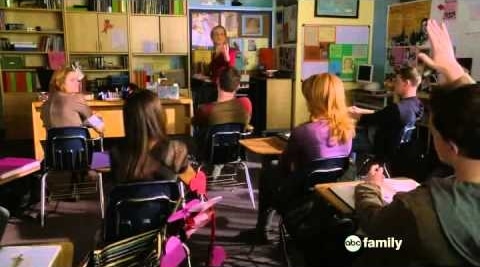
Here is a written transcript of the scene [1]:
Melody: I want to talk about language today. When a deaf child is born, what is the first thing parents hear in the hospital?
Student: “Your child failed the hearing test.”
Melody: Right. A baby is five hours old and he’s failed something already? What about the term ‘hearing loss’? What does that word evoke?
Student: Hearing as the norm. Deaf as less than. Lacking.
Melody: Are we ‘less than’? Do you believe being deaf has taken away or added to your life? If someone invented a pill – you could take it tonight and tomorrow you would wake up hearing – how many of you would take it?
[Students look around shaking their heads]
Melody: None of you. Why not?
Student: Because being deaf gives you friends anywhere you go.
Melody: Yes, community.
Student: And a way of seeing the world that’s different from anyone else.
Melody: Perspective.
Student: Hearing kids don’t know who they are. We do. We’re deaf: first, last, always.
Melody: Identity.
Student: Hearing people think they have more than us – their lives are better, we have it so ‘hard.’ But I’d never give up being deaf to be just like everyone else. Never.
Melody: Yes. Not hearing loss. Deaf gain.
This scene is a great example of Deaf Pride. The students express that if given the chance, they would not choose to hear. There are many benefits that Deaf people who are a part of Deaf Culture are able to experience. In this scene, they say that having a community, a unique perspective, and an identity are all benefits of being Deaf and that none of them would be willing to give that up.
Deaf Pride
One of the most public demonstrations of Deaf Pride was the Deaf President Now (DPN) movement in 1988 at Gallaudet University.
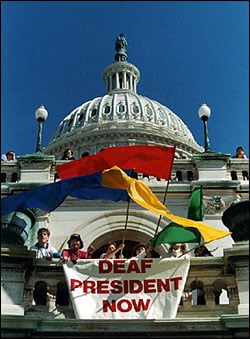
Deaf President Now was a huge protest at Gallaudet University that started in March of 1988. The students, faculty, and staff at the university as well as the national deaf community were united and fought together for one clear goal: to finally have a deaf person run the world’s only deaf university–Gallaudet.
When it came to election time, the University’s Board of Trustees chose a hearing candidate, Elizabeth A. Zinser, as Gallaudet’s seventh president. After six hearing presidents, the staff, faculty, students, and alumni of Gallaudet were ready for a deaf president.
However, the Board of Trustees chose a hearing candidate over two qualified deaf finalists instead.
Everyone was stunned and immediately demanded that a deaf president replace Zinser. A protest broke out. The protestors shut down the entire campus during this movement. They blocked campus entrances; no one could enter the school. Many were arrested and put in jail. These protestors made national headlines. As a united group, the deaf were going to do everything possible until they got their way.
Zinser finally resigned after a week of these protests. I. King Jordan, a faculty member of Gallaudet, became the first deaf president of the University.
The DPN movement unified deaf people of every age and background. They collectively fought until they were heard. They triumphed and proved that they do not have to let society take control of their culture.
One of the best illustrations of the true grit, anger, and pride of the Deaf during DPN is the Deaf President Now episode of Deaf Mosaic. [2]
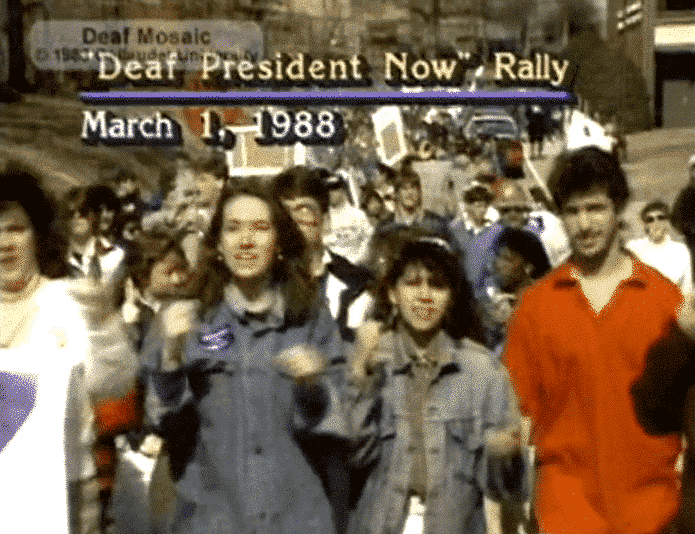
The episode truly encompasses and expresses very well the DPN movement and makes you feel like you were there.
The Deaf President Now movement had a profound impact on not only the Deaf community, but the hearing community at large both in the United States and internationally.
According to an article about Deaf President Now by Gallaudet University, “Deaf President Now (DPN) has become synonymous with self-determination and empowerment for deaf and hard of hearing people everywhere. Perhaps DPN’s most profound impact was felt by hearing people. Deaf people have always known that they could do whatever hearing people could do, but, until DPN, most hearing people did not agree. DPN opened their minds to this reality. At the same time, the movement was a strong reminder to deaf and hard of hearing people that they did not have to accept limitations put on them by others. Indeed, DPN instilled a deep sense of pride and accomplishment in deaf and hard of hearing people of all ages and from all walks of life.” [3]
Following the Deaf President Now movement in 1988, more deaf people began graduating college and entering professions that were previously not believed to be able to be held by those with a hearing loss. It was even said that more laws and bills were passed protecting the deaf and other disabled people in the 5 years following DPN than in the last two centuries combined.
After DPN, many countries began offering college programs for the deaf and in 1989, just one year after DPN, Gallaudet hosted the international Deaf community event “DEAF WAY” where over 6,000 deaf people from all over the world came together to celebrate the Deaf community. And DEAF WAY events continue to this day.
The entertainment industry also changed. Following DPN, more deaf characters and deaf-related storylines were seen in television and movies than ever before. Marlee Matlin was the first deaf person to win an Academy Award in 1986 and following DPN, she was no longer the only recognized deaf person in the entertainment industry. More roles were given to deaf people that showed the deaf as proud individuals rather than people just wishing to hear. One such show is Switched at Birth, which cast a record number of deaf actors and even released the first and only television episode shot using only American Sign Language.
Following DPN, not only are more and more hearing people are learning American Sign Language, but colleges and universities are recognizing American Sign Language to satisfy foreign language requirements – a significant change that many students have come to appreciate. You’ve probably also seen that hearing parents are now encouraged to use sign language with their hearing babies for early communication and language development.
Have you ever seen one week-long movement lead to so much social change? It is clear the impact from the DPN movement in 1988 is still being felt today. Deaf pride is a force to be reckoned with and the power and abilities of the Deaf should never be doubted.
Deaf Pride Quotes
Many Deaf people share their Deaf Pride in interviews in the fantastic documentary Through Deaf Eyes: [4]
“When you talk to people who can hear and you ask them what do you think it would be like to be a deaf person, then all of their thinking is well, I couldn’t do this. Can’t, can’t, can’t, can’t, can’t… they would start listing all the things they can’t do. And I don’t think like that. Deaf people don’t think like that. We think about what we can do…” – I. King Jordan
“What’s wrong with being deaf? I’m deaf. I’m fine. I function fine. I drive. I have a family. I’ve made a baby. I make people laugh. I travel. What the hell is going on? Like I have to hear that has nothing to do with it. It’s all about knowledge; it’s about the heart. It’s about abilities, about doing something you want and getting what you want out of life…Knowledge is the most powerful vehicle to success, not hearing, not speaking…” – CJ Jones
“In terms of a disability, I don’t view myself as having a disability… I function like any other hearing person can. My deafness does not deprive me of anything. I can do anything I want. Except maybe sing.” – Summer Crider
“Being deaf is, well, it’s part of me. It’s something I have to deal with, but it doesn’t keep me from being happy. It doesn’t make me either happy or sad. It’s like being a man instead of a woman, or being tall instead of short.” – David James
“I’m a proud person who happens to be deaf. I don’t want to change it. I don’t want to wake up and suddenly say, ‘Oh my God, I can hear.’ That’s not my dream. It’s not my dream. I’ve been raised deaf. I’m used to the way I am. I don’t want to change it. Why would I ever want to change? Because I’m used to this, I’m happy.” – Marlee Matlin
Disability vs A Cultural and Linguistic Minority
There are many Deaf organizations that have been fighting for more rights for deaf people based on the assertion that Deaf people are part of a ‘cultural and linguistic minority’ group more so than a ‘disability’ group. Even the terms big ‘D’ Deaf (which refers to those who are a part of Deaf culture and use sign language) and little ‘d’ deaf (which refers to those with hearing loss but are not a part of Deaf culture) make this distinction. Many believe that the only ‘disability’ caused by deafness is the communication barrier between the deaf and hearing, and that this barrier does not make them disabled but instead part of a linguistic minority.
“We are not disabled or impaired, we are a linguistic minority.” – Matthew Moore, founder and president of MSM Productions, Ltd. and DEAF.com.
As Rachel Kolb stated in her TED talk, “Deaf children can face significant challenges in acquiring and using language. These challenges are not insurmountable, by any means. But they’re there, because deafness at its core is a communication barrier.” [5]
And a reporter once said, “If all hearing people knew how to sign, deaf people’s so-call disability wouldn’t exist.” [6]
In her TEDx talk titled “Protecting and Interpreting Deaf Culture,” Glenna Cooper states:
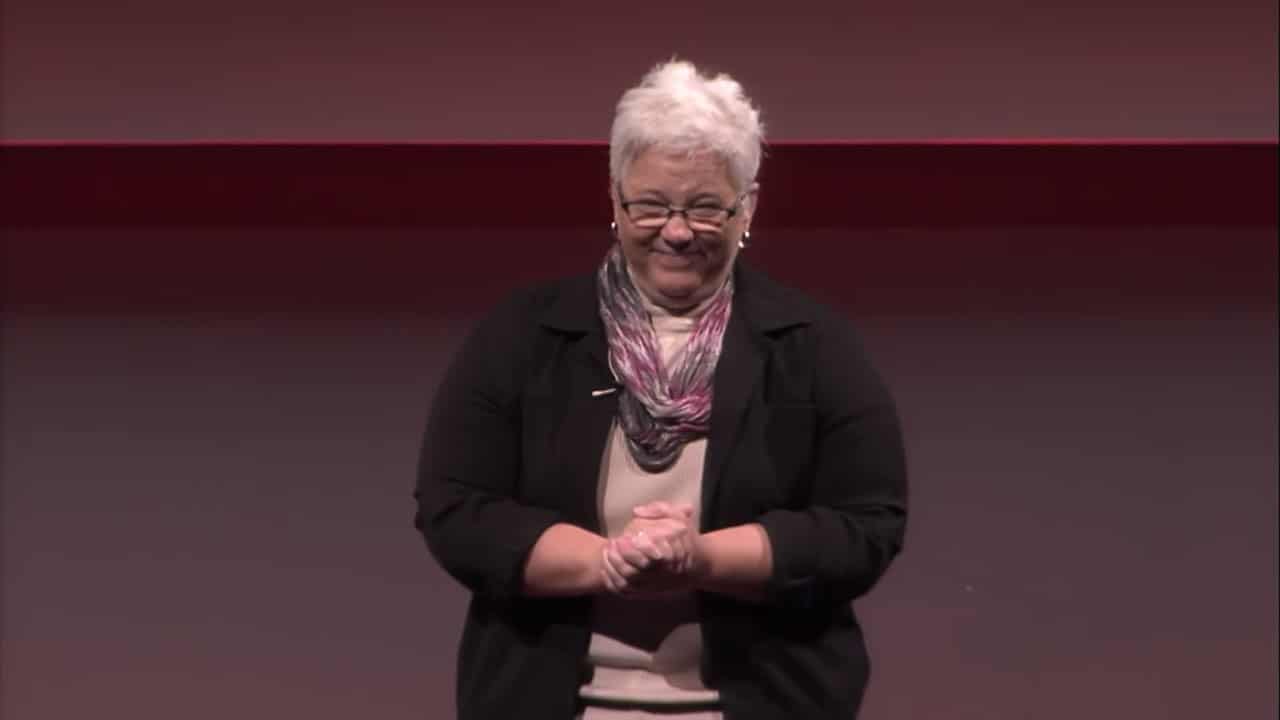
“I’m proud to be deaf. American Sign Language is something that I greatly value because it flung the world wide open for me, even more than I had before.
I love American Sign Language, Deaf culture and Deaf history, and the Deaf community. We know we’re not disabled. We just have a different language. We know who we are. We can do everything just as you can.
We have successful Deaf attorneys, Deaf doctors, scientists, engineers, college professors, athletes, actors – we even have a Deaf receptionist in the white house. When I talk about culture, what do I mean by that I love Deaf culture? We have a culture, just like any other group – Hispanic, Asian, Black – they value their language and their own culture such as we value our own Deaf culture and our own language.” [7]
Currently, many deaf people accept the term ‘disabled’ only insofar as it provides for rights and protections under the law. Today, the deaf must label themselves ‘disabled’ to gain access to hearing society. Because the ‘disability’ label provides protections such as the ADA (Americans with Disabilities Act), deaf people must currently accept this label to receive these types of services. However, these services alone do not include some important rights such as language protection.
So, many Deaf organizations – such as the World Federation of the Deaf and We the Deaf People – are fighting to change that.
The mission of We the Deaf People states: “As members of the Deaf community, we want to be recognized as a linguistic minority, to be accorded the same kind of recognition and respect given to other ethnic groups. We want to preserve American Sign Language, which is the primary language for many of us. The right to have access to, learn, and use ASL, is not a privilege or frill, but a basic human right for all deaf people—children and adults.” [8]
Deaf people being labeled a “cultural and linguistic minority” gives them more specific rights and protections that are offered to similar ethnic groups.
For one example, ethnic groups are entitled to language protection. And as you now know, sign language is the most valued aspect of Deaf culture and essential for the development and education of deaf children. So, they believe that deaf children should have access to sign language as a basic right.
The World Federation of the Deaf participated in the creation of the United Nations Convention on the Rights of Persons with Disabilities (CRPD). The CRPD provides an international framework for the rights of people with disabilities globally and includes minority protections for the deaf that are not yet fully accepted. [9]
The World Federation of the Deaf believes that, “linguistic rights are important for deaf people and should not only be granted within a disability paradigm. Deaf Communities sometimes need linguistic rights as linguistic rights and not as a part of a disability construct.” [10]
The WFD advocates for the application of the protections for the deaf that are already included under the CRPD for:
- The formal and legislative recognition of sign languages – recognizing the equivalence of sign languages to spoken languages.
- The right to give and receive information in sign language.
- Sign language immersion schools and programs and bicultural education and promotion of deaf culture and identity – the environments where deaf children can maximize their academic and social potential.
- Qualified professional sign language interpreters to be provided for equal access to all services.
- For professional deaf educators using sign language to be provided for Deaf children’s education.
- For the recognition, support and promotion of deaf culture and identity.
- Deaf leaders of organizations of the deaf be consulted on matters of policy formulation that affect them.
- And more. [11]
Internationally, the deaf are considered a linguistic minority group under the CRPD, but these protections are not yet fully accepted even in the United States. This is evidenced by the lack of sign language protections for deaf children in education and the continued push to “fix” the deaf through unnatural means such as cochlear implants and speech therapy to try to fit them into hearing society (the disability view) instead of supporting the natural use of sign language as a first language and their development of their Deaf identity and culture (the linguistic minority view).
As learners of American Sign Language, the best way to advocate for the Deaf is to understand and honor the culture and values of the Deaf community. It is true that many Deaf people value their deafness and how it enriches their lives through Deaf culture, language, community, pride, identity, experience, and advocacy. Many do not view themselves as disabled, but instead as part of a rich cultural and linguistic minority group that deserves acceptance and preservation. Taking the step to truly learn and understand the beliefs and values of Deaf culture, and honor them in your interactions, is the best thing you can do as a steward of the language.
Resources:
[1] “Not hearing loss, deaf gain.” Switched at Birth | ABC Family. Posted 11 February 2013. https://youtu.be/F5W604uSkrk. Accessed 6 July 2020.
[2] “Deaf Mosaic 402: Deaf President Now.” Gallaudet University. 30 April 2020. https://media.gallaudet.edu/media/Deaf+Mosaic+402A+Deaf+President+Now/1_09xzy4hx/162384581. Accessed 6 July 2020.
[3] “Deaf President Now: Impact.” Gallaudet University. Updated 2010. https://www.gallaudet.edu/about/history-and-traditions/deaf-president-now/impact. Accessed 6 July 2020.
[4] “History Through Deaf Eyes: Discussion Questions” Gallaudet University. https://www.gallaudet.edu/history-through-deaf-eyes/educational-resources/documentary-discussion-guide/discussion-questions. Accessed 10 September 2020.
[5] Kolb, Rachel. “Navigating deafness in a hearing world.” TEDxStanford. 20 June 2013. https://youtu.be/uKKpjvPd6Xo. Accessed 6 July 2020.
[6] “Deaf President Now: Impact.” Gallaudet University. Updated 2010. https://www.gallaudet.edu/about/history-and-traditions/deaf-president-now/impact. Accessed 6 July 2020.
[7] Cooper, Glenna. “Protecting and Interpreting Deaf Culture.” TEDxTulsaCC. 22 May 2017. https://youtu.be/io7z5PftOU4. Accessed 6 July 2020.
[8] “Goals/Mission.” We the Deaf People. 2018. https://www.wtdp.org/. Accessed 6 July 2020.
[9] “Our Work: CRPD.” World Federation of the Deaf. http://wfdeaf.org/our-work/crpd/. Accessed 6 July 2020.
[10] Down, Elena and Dr. Robert Adam. “WFD Position Paper – Deaf Community as linguistic identity or disability.” World Federation of the Deaf. March 2017. https://wfdeaf.org/wp-content/uploads/2018/07/LM-and-D-Discussion-Paper-FINAL-11-May-2018.pdf Accessed 6 July 2020.
[11] Down, Elena and Dr. Robert Adam. “WFD Position Paper – Deaf Community as linguistic identity or disability.” World Federation of the Deaf. March 2017. https://wfdeaf.org/wp-content/uploads/2018/07/LM-and-D-Discussion-Paper-FINAL-11-May-2018.pdf Accessed 6 July 2020.
Start Learning ASL Today!
 Ready to start learning real American Sign Language and not just basic signs? Do you want to be a part of the vibrant Deaf community? Check out our Free ASL 1 Course or our Complete 4-Level ASL Course options and start learning ASL today!
Ready to start learning real American Sign Language and not just basic signs? Do you want to be a part of the vibrant Deaf community? Check out our Free ASL 1 Course or our Complete 4-Level ASL Course options and start learning ASL today!





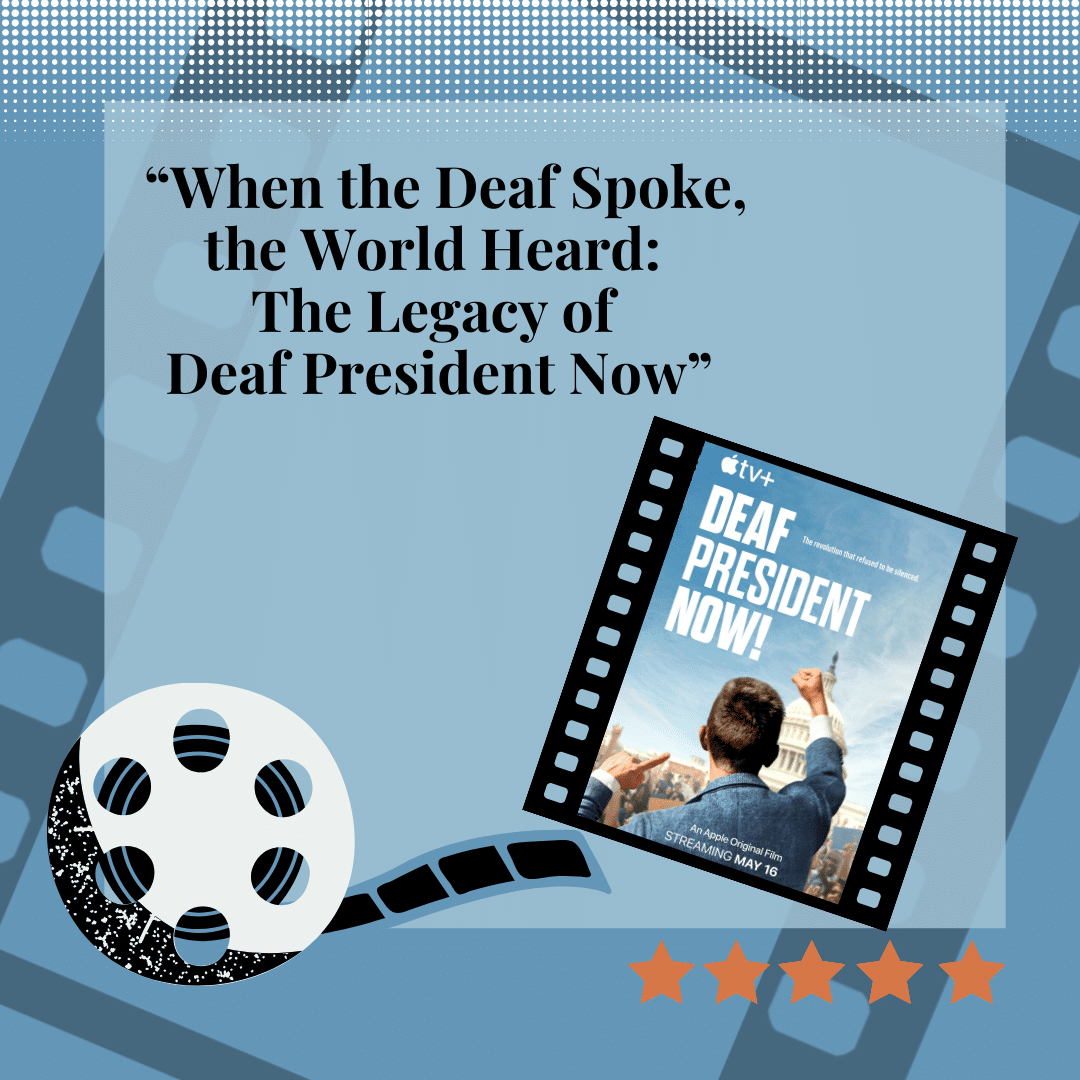



One Response
It’s important to learn about these things because they are important to the deaf community!